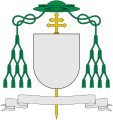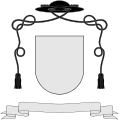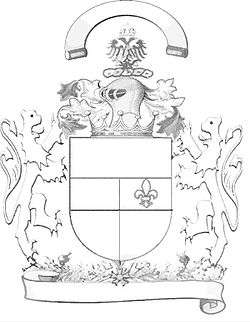Helmet (heraldry)
| Part of a series on |
| Heraldic achievement |
|---|
| Conventional elements of coats of arms |
|
|
In heraldic achievements, the helmet or helm is situated above the shield and bears the torse and crest. The style of helmet displayed varies according to rank and social status, and these styles developed over time, in step with the development of actual military helmets.[1][2] In some traditions, especially German and Nordic heraldry, two or three helmets (and sometimes more) may be used in a single achievement of arms, each representing a fief to which the bearer has a right. For this reason, the helmets and crests in German and Nordic arms are considered to be essential to the coat of arms and are never separated from it.
Open-visored or barred helmets are typically reserved to the highest ranks of nobility, while lesser nobility and burghers typically assume closed helms.[2] While these classifications remained relatively constant, the specific forms of all these helmets varied and evolved over time.[2] The evolution of these heraldic helmets followed the evolution of combat techniques and tourneying in the Middle Ages. The practice of indicating rank through the display of barred or open-face helmets did not appear until around 1615,[3] however, long after the practice of heraldry had been established. As jousting with lances was supplanted by tourneying with maces, the object being to knock the opponent's crest off his helmet, the fully enclosed helmet gave way to helmets with enlarged visual openings with only a few bars to protect the face. These barred helmets were restricted by the imperial chancellery in Vienna to the nobility and certain doctors of law or theology, while the jousting helm was freely adopted by anyone.[4] The direction a helmet faces and the number of bars on the grille have been ascribed special significance in later manuals, but this is not a period practice.[5] A king's helmet, a golden helmet shown affronté with the visor raised, crowned with a royal crown, became adopted by the kings of Prussia.[5] In ecclesiastical heraldry, bishops and other clergy use a mitre or other rank-appropriate ecclesiastical hat in place of a helmet.[6]
Historically, however, the helmet was not specifically granted in an achievement of arms, but was naturally assumed by appropriate rank as a matter of "inherent right", so a helmet with torse and mantling would not be misplaced even above a shield which had no crest to place above it.[7] When multiple crests need to be depicted, the time honoured practice in English heraldry is to draw the crests above a single helmet, each being separated from it, while in German heraldry, where multiple crests appear frequently after the 16th century, each crest is always treated as inseparable from its own helmet and turned in agreement with the helmet.[8] In continental Europe, multiple helmets were usually turned inward, with the center helm (if an odd number) turned affrontê, while in Scandinavian heraldry the helmets were usually turned outward.[9] The arms of the last margraves of Brandenburg-Ansbach consist of a shield with 21 quarterings topped with a record thirteen helmets and crests.[10]
The usage of heraldic helmets in Britain is as follows: Gold helmet with bars for the Royal Family; Silver helmet with gold bars for peers; Steel helmet with gold bars for the non-peerage Scottish feudal baron; Open steel helmet shown affronté for knights and baronets; Steel tournament helm for Scottish clan chiefs; Closed steel helmet for esquires and gentlemen.[11]
Gallery
General
 Open or barred helmet, reserved for members of the nobility
Open or barred helmet, reserved for members of the nobility Closed or tilting helm, used by medieval knights, also adopted by English esquires and gentlemen, as well as on burgher arms
Closed or tilting helm, used by medieval knights, also adopted by English esquires and gentlemen, as well as on burgher arms
Ecclesiastical
In the Roman Catholic Church, clerics entitled to a coat of arms use a galero instead of a helmet, which is considered too belligerent for men in holy orders.
 Galero gules with fifteen tassels per side, used by cardinals in place of a helmet (and patriarchal cross)
Galero gules with fifteen tassels per side, used by cardinals in place of a helmet (and patriarchal cross) Galero vert with ten tassels per side, used by archbishops in place of a helmet (and patriarchal cross)
Galero vert with ten tassels per side, used by archbishops in place of a helmet (and patriarchal cross) Galero vert with six tassels per side, used by bishops in place of a helmet (and single-barred cross)
Galero vert with six tassels per side, used by bishops in place of a helmet (and single-barred cross) Galero sable with one tassel per side (and blank shield), used by armigerous priests in place of a helmet
Galero sable with one tassel per side (and blank shield), used by armigerous priests in place of a helmet
Notes
- ↑ Woodcock (1988), p. 202.
- 1 2 3 Fox-Davies (1909), p. 303.
- ↑ Fox-Davies (1909), p. 319.
- ↑ Neubecker (1976), pp. 148, 162.
- 1 2 Neubecker (1976), p. 148.
- ↑ Woodcock (1988), p. 75.
- ↑ Fox-Davies (1909), p. 58.
- ↑ Fox-Davies (1909), pp. 322-323.
- ↑ Fox-Davies (1909), p. 323.
- ↑ Neubecker (1976), p. 165.
- ↑ Iain Moncrieffe and Don Pottinger (1953). Simple Heraldry Cheerfully Illustrated. Thomas Nelson and Sons. p. 58.
References
- Fox-Davies, Arthur Charles; Graham Johnston (1909, 2004). A Complete Guide to Heraldry. Kessinger Publishing. ISBN 1-4179-0630-8
- Neubecker, Ottfried (1976). Heraldry: Sources, Symbols and Meaning. Maidenhead, England: McGraw-Hill. ISBN 0-07-046308-5
- Woodcock, Thomas; John Martin Robinson (1988). The Oxford Guide to Heraldry. New York: Oxford University Press. ISBN 0-19-211658-4
Internal links
 Media related to Heraldic helmets at Wikimedia Commons
Media related to Heraldic helmets at Wikimedia Commons

